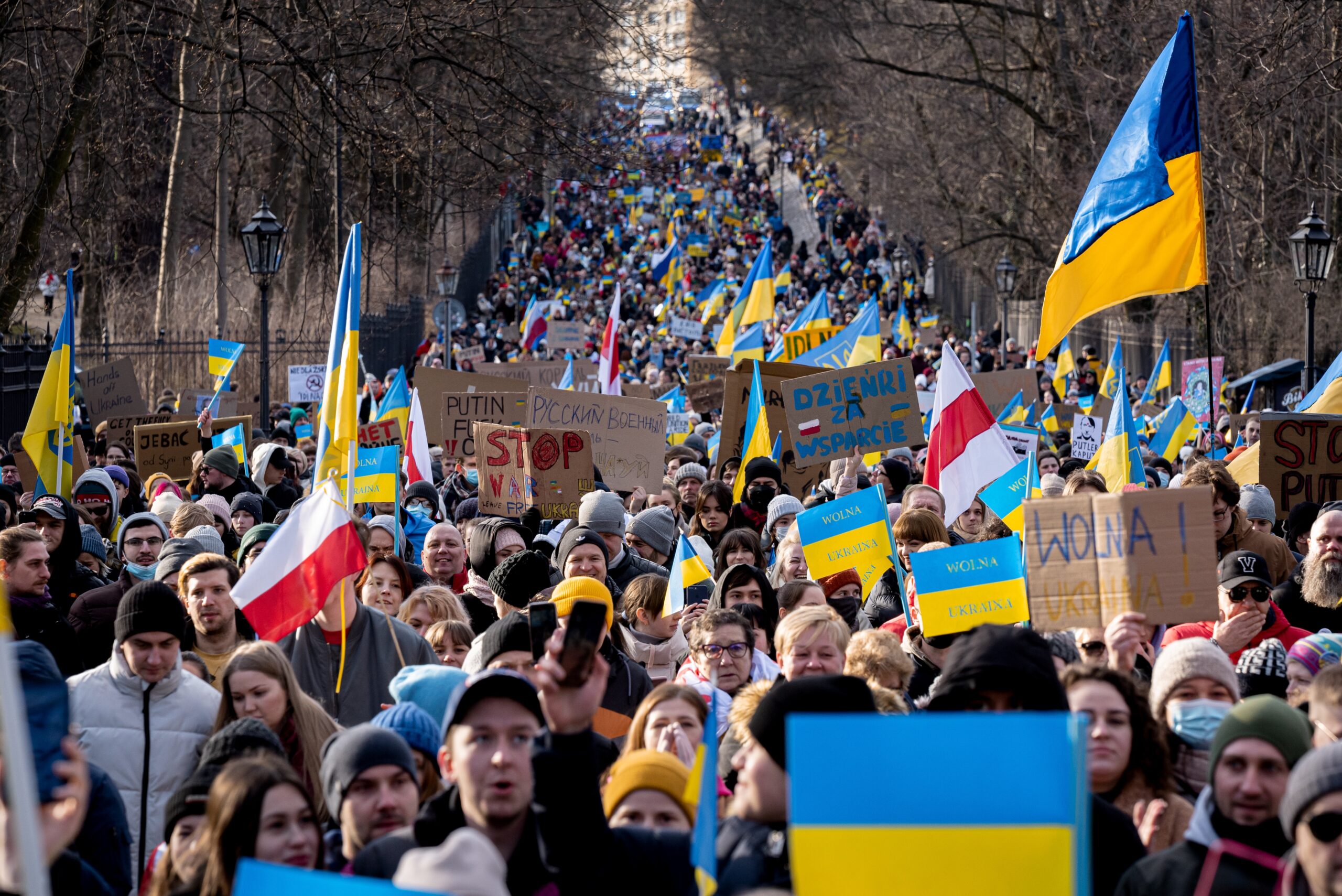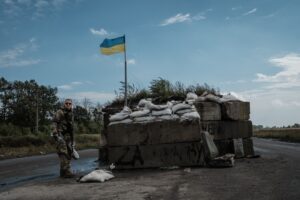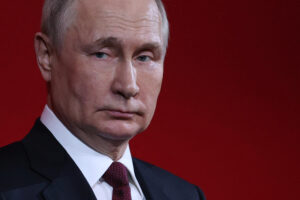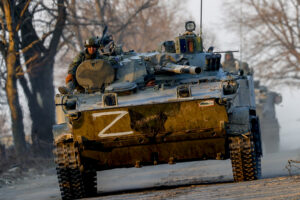
His military didn’t just fail. Ordinary Ukrainians, Russians, and people across the globe are creatively and nonviolently protesting Putin’s war on Ukraine, and they are making a difference.
By Srdja Popovic and Steve Parks
February 2023
February 24 marks the first anniversary of Vladimir Putin’s massive invasion of Ukraine.
We are already seeing a flood of news articles and television stories offering expert analysis of why the Russian military faltered and why the world did not anticipate Ukraine’s heroic resistance against a supposedly all-powerful autocrat. These voices focus on the same things: the military and geopolitics. But there is a different aspect to this conflict — the crucial importance of nonviolent efforts occurring locally, regionally, and globally — that is being overlooked.
For Ukraine, the story begins with two recent and significant events: the Orange Revolution in 2004 and the EuroMaidan Revolution in 2013. These national nonviolent mobilizations demonstrated that Ukrainians could defend their democratic institutions and kick out officials who attempted to cheat them. It should not surprise us then that wherever Russian occupation forces attempted to plant their boots and flags, Ukrainians confronted them with an array of nonviolent tactics, ranging from leaflets and graffiti to mass noncooperation and physical blockades of Russian tanks by unarmed citizens.
The antiwar efforts of Russian citizens, meanwhile, demonstrate how nonviolent tactics are eroding internal support and disrupting the Kremlin’s messaging about the “special operation.” Ordinary Russians have performed small acts of resistance. Brave journalists such as Marina Ovsyannikova have interrupted prime-time TV newscasts to speak out against the invasion. And activists have launched subversive and creative “dilemma actions” — for example, replacing price tags with antiwar protest messages and carrying blank signs at protests after police arrested demonstrators waving signs with antiwar messages. (The “blank-sign” protesters were still arrested, however.) People from all cross-sections of society have participated in mass protests, which have seen more than 19,000 arrested.
Russians even flipped the Kremlin’s attempted mass mobilization into an opportunity for mass noncooperation: Hundreds of thousands of Russians, including many working in lucrative sectors such as IT, “voted with their feet” by escaping to Azerbaijan, Georgia, Kazakhstan, and Serbia. In the long term, this “brain drain” will cripple Russia’s human capital far more severely than any sanctions. Members of the Russian diaspora, a group who in the past had generally been pro-Putin, have staged creative protests across Europe — in one instance creating an “alternative Russian flag” with the red stripe missing to symbolically erase Putin’s bloody wars from the nation’s history. The embattled Belarusian president Alyaksandr Lukashenka, who has typically been willing to do Moscow’s bidding, was reluctant to join the war. Years of nonviolent protest in Belarus, coupled with Belarusian railway workers and hackers sabotaging signaling equipment to limit Russia’s ability to move supplies, curtailed Lukashenka’s power to act unilaterally. Without the collective power of such nonviolent movements, we might have witnessed a much larger Russian Army, joined by Belarusian troops, advancing on Kyiv last spring.
What about the larger global community? Immediately after the invasion, an unprecedented number of global protests occurred in support of Ukraine. According to #WorldForUkraine, there have been more than 12,679 protests in 87 different countries in the past year. Ukrainian borscht has become a fundraising tool, with individuals cooking Ukrainian meals for friends and collecting donations. Countless petitions have been created. Famous artists and top athletes have spoken out in solidarity. Graffiti and murals have remade public spaces in countries such as Norway, France, Germany, and Mexico. In several world capitals, protesters have vandalized Russian embassies with paint, while landmark buildings across the globe have been lighting up in the colors of the Ukrainian flag. Such actions send a clear message to the people of Ukraine: You are not alone. And if you talk to everyday Ukrainians, you know that means a lot.
Beyond symbolism, global supporters are also acting. Irish fisherman have challenged Russian warships, persuading them that their planned naval exercises would damage the fishermen’s livelihoods. And harbor workers worldwide have refused to unload Russian containers. Understanding that they have power to help Ukraine, millions have joined the #boycottrussia campaign, which encourages people to support companies such as McDonald’s that quickly pulled their business from Russia. Companies that still operate in Russia have come under public scrutiny and pressure to divest. And those choosing to remain have been publicly shamed. Finally, notorious Russian business tycoons and oligarchs — just 400 oligarchs control more than half of Russia’s wealth — have also come under intense pressure. Symbols of their lavish lifestyles abroad, such as multimillion-dollar yachts, mansions, and (in the case of Roman Abramovich) flagship soccer clubs, have been frozen, confiscated, or forcibly sold.
The unprecedented pressure and mobilization of thousands of people have played a role in moving governments across the democratic world to set a clear course of action: Support Ukraine. Put a price tag on the Russian invasion. Put your money (and military equipment) “where your mouth is.” This pressure has helped push governments that were initially reluctant to engage, such as Germany, to join this international campaign. And now, Putin is losing his political “friends” in Europe. As his waning influence abroad is being documented in mainstream media, his European allies, mostly coming from the far right, are facing a tough choice: Stand with their patron and be ostracized by their own people (see, for example, ex–German chancellor and Gazprom board member Gerhard Schröder) or publicly backpedal (as when Marine le Pen, in the midst of her 2022 French presidential campaign, had hundreds of thousands of campaign leaflets featuring a photo of her with Putin quietly destroyed). Were it not for thousands of people mobilizing nonviolently, we can bet that at least some politicians would still be dragging their feet or aligning themselves with Putin.
Putin seems to be losing his hold on the virtual world as well. A cyberspace dominated for more than a decade by pro-Russian trolls and conspiracy theorists is now challenging the authoritarian image of Putin. Millions of ordinary Facebook and Twitter users are sharing offensive (and sometimes hilarious) memes of the Russian autocrat. The leader who once presented himself as a shirtless strongman taming horses has been turned into an online villain and, more painfully for his huge ego, a punchline. Although his well-organized machinery of Russian propaganda troll farms is still holding the dam, especially in the Global South, it is clear that Russia’s “Online Empire” is on the defensive. Russia is now tasting its own medicine. The “hactivist” collective Anonymous has successfully launched thousands of cyberattacks, ranging from the embarrassing (hacking Russian propaganda TV stations to broadcast Russia’s military humiliation in Ukraine) to the truly disruptive (denial-of-service, or DDoS, attacks on vital public services and businesses).
If we take a wider look at this conflict, it’s fair to say that both the resilience and bravery of the Ukrainian people as well as the global mobilization in their support has taught the world an important lesson: Despite more than a decade of decay, the forces in support of democracy are still resilient. This battle between autocracy and democracy offers a glimmer hope by showing how the mobilization of everyday people locally, nationally, and globally can help us move toward putting a solid share of the planet back on the path to respecting and defending democracy. And while brave Ukrainians have reminded us that democracy and freedom are values worth giving your life for, they have also taught us an important second lesson: The rest of us must not let Ukrainians stand alone, as there are so many nonviolent methods by which we can help and act — wherever we are.![]()
Srdja Popovic is founder of the Center for Applied Nonviolent Action and Strategies (CANVAS) and lecturer at Colorado College and the University of Virginia. He is coauthor of Blueprint for Revolution: How to Use Rice Pudding, Lego Men, and Other Nonviolent Techniques to Galvanize Communities, Overthrow Dictators, or Simply Change the World (2015). His Twitter handle is @SrdjaPopovic. Steve Parks is professor of English at the University of Virginia. He is also chair of the Democratic Futures Project, an alliance of academics and international advocates dedicated to supporting research as well as programs that expand democratic practices and governance. His Twitter handle is @StephenJParks.
Copyright © 2023 National Endowment for Democracy
Image Credit: Shutterstock.com/Damian Lugowski
| FURTHER READING | ||

Why Ukraine Is Starting to LosePutin doesn’t care how many of his troops die. He is looking to win a war of attrition. On the second anniversary of Russia’s invasion, Ukraine needs the West’s help—and it needs it now. |

Why Vladimir Putin’s Luck Ran OutFor twenty years, the Russian autocrat enjoyed a string of good fortune in coming to power and cementing his rule. He had raised Russia’s standing in the world. Then he invaded Ukraine. |

Putin’s War of RecolonizationRenée de Nevers and Brian D. Taylor Russia’s invasion of Ukraine isn’t just another land grab. It’s an attempt to recolonize lost empire, and threatens to return us to the age of conquest. |
